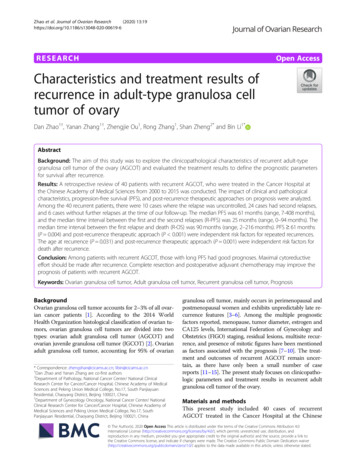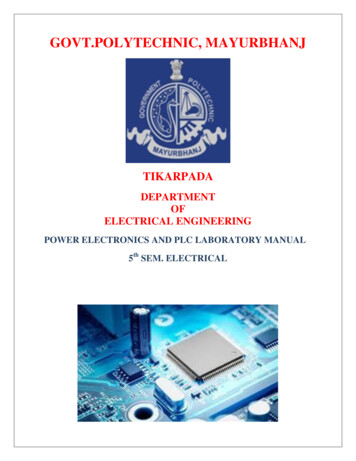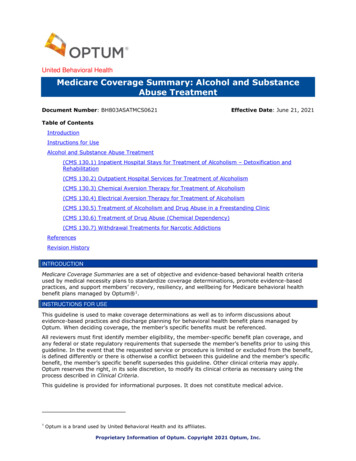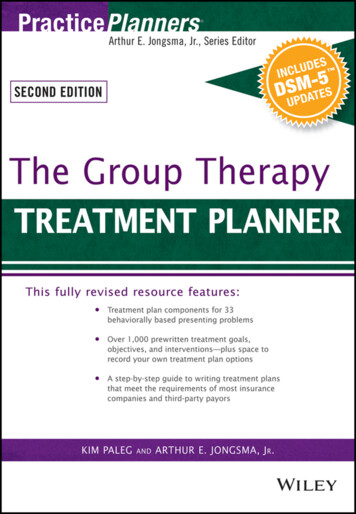
Transcription
Zhao et al. Journal of Ovarian Research(2020) EARCHOpen AccessCharacteristics and treatment results ofrecurrence in adult-type granulosa celltumor of ovaryDan Zhao1†, Yanan Zhang1†, Zhengjie Ou1, Rong Zhang1, Shan Zheng2* and Bin Li1*AbstractBackground: The aim of this study was to explore the clinicopathological characteristics of recurrent adult-typegranulosa cell tumor of the ovary (AGCOT) and evaluated the treatment results to define the prognostic parametersfor survival after recurrence.Results: A retrospective review of 40 patients with recurrent AGCOT, who were treated in the Cancer Hospital atthe Chinese Academy of Medical Sciences from 2000 to 2015 was conducted. The impact of clinical and pathologicalcharacteristics, progression-free survival (PFS), and post-recurrence therapeutic approaches on prognosis were analyzed.Among the 40 recurrent patients, there were 10 cases where the relapse was uncontrolled, 24 cases had second relapses,and 6 cases without further relapses at the time of our follow-up. The median PFS was 61 months (range, 7-408 months),and the median time interval between the first and the second relapses (R-PFS) was 25 months (range, 0–94 months). Themedian time interval between the first relapse and death (R-OS) was 90 months (range, 2–216 months). PFS 61 months(P 0.004) and post-recurrence therapeutic approach (P 0.001) were independent risk factors for repeated recurrences.The age at recurrence (P 0.031) and post-recurrence therapeutic approach (P 0.001) were independent risk factors fordeath after recurrence.Conclusion: Among patients with recurrent AGCOT, those with long PFS had good prognoses. Maximal cytoreductiveeffort should be made after recurrence. Complete resection and postoperative adjuvant chemotherapy may improve theprognosis of patients with recurrent AGCOT.Keywords: Ovarian granulosa cell tumor, Adult granulosa cell tumor, Recurrent granulosa cell tumor, PrognosisBackgroundOvarian granulosa cell tumor accounts for 2–3% of all ovarian cancer patients [1]. According to the 2014 WorldHealth Organization histological classification of ovarian tumors, ovarian granulosa cell tumors are divided into twotypes: ovarian adult granulosa cell tumor (AGCOT) andovarian juvenile granulosa cell tumor (JGCOT) [2]. Ovarianadult granulosa cell tumor, accounting for 95% of ovarian* Correspondence: zhengshan@cicams.ac.cn; libin@cicams.ac.cn†Dan Zhao and Yanan Zhang are co-first authors2Department of Pathology, National Cancer Center/ National ClinicalResearch Center for Cancer/Cancer Hospital, Chinese Academy of MedicalSciences and Peking Union Medical College, No.17, South PanjiayuanResidential, Chaoyang District, Beijing 100021, China1Department of Gynecology Oncology, National Cancer Center/ NationalClinical Research Center for Cancer/Cancer Hospital, Chinese Academy ofMedical Sciences and Peking Union Medical College, No.17, SouthPanjiayuan Residential, Chaoyang District, Beijing 100021, Chinagranulosa cell tumor, mainly occurs in perimenopausal andpostmenopausal women and exhibits unpredictably late recurrence features [3–6]. Among the multiple prognosticfactors reported, menopause, tumor diameter, estrogen andCA125 levels, International Federation of Gynecology andObstetrics (FIGO) staging, residual lesions, multisite recurrence, and presence of mitotic figures have been mentionedas factors associated with the prognosis [7–10]. The treatment and outcomes of recurrent AGCOT remain uncertain, as there have only been a small number of casereports [11–15]. The present study focuses on clinicopathologic parameters and treatment results in recurrent adultgranulosa cell tumor of the ovary.Materials and methodsThis present study included 40 cases of recurrentAGCOT treated in the Cancer Hospital at the Chinese The Author(s). 2020 Open Access This article is distributed under the terms of the Creative Commons Attribution 4.0International License (http://creativecommons.org/licenses/by/4.0/), which permits unrestricted use, distribution, andreproduction in any medium, provided you give appropriate credit to the original author(s) and the source, provide a link tothe Creative Commons license, and indicate if changes were made. The Creative Commons Public Domain Dedication o/1.0/) applies to the data made available in this article, unless otherwise stated.
Zhao et al. Journal of Ovarian Research(2020) 13:19Academy of Medical Science from 2000 to 2015, including 7 cases who received the initial treatment in our hospital and 33 cases who received the initial treatment inother hospitals. All patients had follow-ups until May2019. Recurrence was recorded only in patients provento be tumor-free after initial treatment (i.e., having noresidual tumor after surgery or chemotherapy, the latterbeing dependent upon a clean computed tomography[CT] scan). The recurrent site was judged by a CT scanor during cytoreductive surgery, and multisite recurrence was defined as tumors found at more than twoanatomical regions. Initial and post-recurrent clinicalfeatures and therapeutic approaches—including age,menopause status, surgical approaches, tumor staging,chemotherapy status, recurrent site, post-recurrencetherapeutic approaches—were reviewed from the medical records. Histopathological sections of surgical specimens were retrieved and reviewed by a seniorpathologist to record and analyze tumor necrosis, atypia,hemorrhage, mitotic figures, and immunohistochemicalbiomarkers. The prognosis-related data were obtainedthrough telephone interviews and outpatient follow-ups.SPSS 23.0 software (IBM SPSS., Chicago, IL) were usedfor data analysis. The influencing factors of recurrentprogression-free survival (R-PFS) and recurrent overallsurvival (R-OS) were analyzed by the Kaplan-Meiermethod, and the comparison was performed using thelog-rank method. The risk factors of second recurrencewere analyzed by univariate and multivariate analysesusing the Cox proportional hazard regression. A P 0.05was considered as a statistically significant difference.The research protocol of this study was approved by theEthics Committees of the National Cancer Center/Cancer Hospital at the Chinese Academy of MedicalSciences.ResultsPatient and tumor characteristics at initial diagnosisThe age of initial disease onset was 21–62 years, with amedian age of 44.5 years. There were 14 cases of menopause at the initial treatment and 26 cases withoutmenopause. Among the 40 cases, 37 patients had givenbirth, and 3 patients had never given birth. The commonclinical manifestations were abdominal pain/distension,a pelvic mass, and vaginal bleeding. There were 10 casesof abdominal pain and distension, 20 cases of a pelvicmass, and nine cases of vaginal bleeding. All casesunderwent surgery as the initial treatment. Fourteencases underwent fertility-preservation surgical procedures, including three cases of cystectomy, eight cases ofunilateral adnexectomy, and three cases of unilateraladnexectomy and omentectomy. The remaining 26 caseshad a hysterectomy and bilateral salpingo-oophorectomy(HBSO), as well as staging and cytoreductive surgery. OfPage 2 of 10all patients, 18 cases were staged and 22 cases were notstaged. Five patients underwent lymphadenectomy, and 35patients had no lymphadenectomy. For FIGO staging,there were 30 cases of stage I, including 3 cases of stageIa, 15 cases of stage Ic, and 12 cases of stage Ix (eitherstage Ia or Ic); there were 5 cases of stage II and 5 cases ofstage III. Among all patients, 11 cases had no postoperative chemotherapy, and 29 cases had postoperativechemotherapy. Of the cases receiving postoperativechemotherapy, there were 8 cases of BEP regimen, 9 casesof TC/ paclitaxel plus cisplatin (TP) regimen, and 12 casesof other regimens. Sixteen patients received chemotherapyfor four cycles or less, and 13 patients received chemotherapy for more than four cycles (Table 1).Clinicopathological features and therapeutic approachesat recurrenceAmong the 40 patients with recurrence, the PFS was 7–408 months and the median was 61 months; the OS was34–493 months, with a median of 126 months. The ageat recurrence ranged from 22 to 77 years, with a medianof 50.6 years old. There were 19 cases that had clinicalsymptoms, while 16 cases were asymptomatic in whichthe recurrence was discovered by imaging examinationduring follow-ups. The other five cases had no record ofwhether they had symptoms. The recurrence sites included pelvic recurrence in 15 cases, multisite recurrences in the abdominopelvic cavity in 24 cases, andlung metastasis with pleural effusion in 1 case. Eight patients had recurrence of a single lesion, and 32 patientshad recurrence of multiple lesions. Among the cases inwhich the recurrent lesions involved the abdominal cavity, seven cases involved the greater omentum; five casesinvolved the liver; three cases involved the perisplenicregion; four cases involved the abdominal wall. Amongthe patients with recurrence, the post-recurrence therapeutic approaches included 3 cases of surgery alone, 6cases of chemotherapy alone, and 31 cases of surgerycombined with adjuvant chemotherapy. Twenty-fourhad second recurrences and 11 had third recurrences. Atotal of 18 deaths were reported (Fig. 1). Among the 34patients with post-recurrence surgery, 23 patients underwent complete resection of the lesion, and 11 patientshad residual lesions after the surgery. Among the 31 patients with post-recurrence chemotherapy, 9 patientsunderwent a BEP regimen; 16 patients underwent paclitaxel plus platinum-based regimens; 6 patients underwent other chemotherapeutic regimens. Ten patientshad four-cycles chemotherapy, and 21 patients had four-cycles chemotherapy. Reviewing of the pathologicalreports of the 40 patients with recurrence showed that20 patients had inhibin-A examination, including 18positive cases ( ) and 2 negative cases. Eleven patients had vimentin examination, including only 1
Zhao et al. Journal of Ovarian Research(2020) 13:19Page 3 of 10Table 1 Patient and tumor characteristics at initial diagnosis(N 40)Characteristicsn (N 40)%Age21–6244.5 (median)Place of initial treatmentOur hospital717.5%Other ral3895%Bilateral25%Fertility preserve1435%No turitionMenopauseStageSidesurgery at initial diagnosisStagingLymphadenectomyAdjuvant chemotherapyChemotherapy regimen(N 29)negative case and 10 positive cases ( ). Eleven patients had an S-100 protein examination, including 10positive cases ( ) and 1 negative case; 15 patientshad a Ki-67 protein examination, with only 1 case was60% and the rest were below 30%. Among the 22 caseswith histopathological sections of post-recurrence surgical specimens being retrieved and reviewed by a seniorpathologist, 4 patients had necrosis and 18 patients didnot have necrosis. There were 10 cases of mild atypia, 11cases of moderate atypia, and 1 case of severe atypia.There were 20 cases of hemorrhage and 2 cases withouthemorrhage There were 6 cases of five mitotic figures/HPF and 16 cases of 5 mitotic figures/HPF (Table 2).Analysis of the influencing factors of R-PFS and R-OSUntil the last follow-up in May 2019, the follow-up duration of the 40 patients with recurrence was 57–298months, with a median follow-up of 134 months. The RPFS was defined as the time between the start of thepost-recurrence treatment and the repeated recurrenceor disease progression in the patient, or between thestart of the post-recurrence treatment and the time ofthe last follow-up of the patients with no progressivedisease. The R-OS was defined as the time from the startof the post-recurrence treatment until the death of thepatients or the last follow-up. Our results showed thatthe R-PFS of the patients ranged from 0 to 94 months,with a median R-PFS of 25 months. The R-OS of the patients ranged from 2 to 216 months, with a median ROS of 90 months. The three-year survival rate after recurrence was 82.4%, and the five-year survival rate afterrecurrence was 76.6%.Univariate analysis of recurrence features and the effectof post-recurrence therapeutic approaches on the prognosis of recurrent AGCOT showed that PFS (P 0.014),post-recurrence therapeutic approach (P 0.001), andpost-recurrence atypia of surgical pathology (P 0.030)had significant impacts on R-PFS. Additionally, postrecurrence therapeutic approach (P 0.002) and completeresection after recurrence (P 0.003) had significant impacts on R-OS. Patients with PFS 61 months, postrecurrence surgery combined with adjuvant chemotherapy, and mild atypia had a relatively long R-PFS. Coxmultivariate analysis—including the age at recurrence,PFS, single/multisite recurrence, and post-recurrencetherapeutic approach—showed that the PFS 61 monthsand the post-recurrence therapeutic approach were independent risk factors for second recurrence.Patients with PFS 61 months had a 3.5-fold higherrisk of a second recurrence than patients with PFS 61months. Patients with post-recurrence surgery alone andpost-recurrence chemotherapy alone had 10.6-fold and15-fold higher risks of a second recurrence, respectively,than those of patients with surgery combined with adjuvant chemotherapy. The age at recurrence 50 years(P 0.031) and post-recurrence therapeutic approaches(P 0.001) were independent risk factors for postrecurrence death. Patients who were 50 years old at recurrence had a 3.3-fold higher risk of death compared tothat of patients who were 50 years old at recurrence.Patients with post-recurrence chemotherapy alone had a13.4-fold higher risk of death than that of patients withpost-recurrence surgery combined with chemotherapy(Table 3). Figure 1 shows the outcome of the 40 patientswith recurrent AGCOT. Effects of PFS and post-
Zhao et al. Journal of Ovarian Research(2020) 13:19Page 4 of 10Fig. 1 Clinical outcomes of 40 patients with recurrent AGCOT, including 18 deaths and 22 survival cases. Abbreviations: s, surgery;c, chemotherapyrecurrence therapeutic approach on R-PFS, as well as effects of post-recurrence therapeutic approach and postrecurrence complete resection of lesions on R-OS, arepresented in the survival curves in Fig. 2.Analysis of the 34 patients with post-recurrence surgery showed that PFS 61 months and postoperativechemotherapy (P 0.001) were independent risk factorsfor a second recurrence. Patients with PFS 61 monthshad a 5.4-fold higher risk of a second recurrence thanthat of patients with PFS 61 months. Patients withoutcomplete resection of lesions had a 6.6-fold higher riskof death than that of patients with complete resection oflesions (P 0.003; Table 4).DiscussionApproximately 75% of patients with AGCOT are at stageI, with the lesion being confined to the ovary. Surgicalresection is the main treatment for AGCOT and resultsin good prognosis. In the present study, 30 (75%) out of40 patients with recurrent AGCOT were at stage I diagnosis. However, 20–25% of AGCOT patients would haverecurrence and are characterized by long-term recurrence, with a median recurrence time of 4–6 years afterthe initial treatment, and as long as 40 years after thetreatment [5]. Due to the low incidence and recurrencerates and long recurrence time of AGCOT, the therapeutic and prognostic analyses of post-recurrence caseshave been relatively rare. Only a small number of recurrence cases have been reported [5, 8, 11, 13, 14, 16]. Thelargest report currently available is from a multicenterstudy in Taiwan, with a total of 44 cases of recurrence thathad a median PFS and OS of 61.5 months and 115.3months, respectively [15]. Dridi et al. reported that theaverage PFS was 8.4 years, and the average OS was 13years [3]. Results of the present study are consistent withprevious findings. As the largest single-center case studyof recurrent AGCOT, the present study showed that 40recurrent cases had a median PFS of 61 months and a median OS of 126 months, with the post-recurrence threeyear survival rate of 82.4% and five-year survival rate of76.6%. The PFS 61 months was the independent risk factor of second recurrence. We speculate that this resultmay be due to patents with a short PFS being prone to developing drug resistance to platinum-based chemotherapy,thereby reducing the efficacy of post-recurrence chemotherapy. Patients with longer PFS have better sensitivity torepeated chemotherapy after recurrence. The PFS is animportant factor in predicting the chemotherapy sensitivity and prognosis for patients with recurrent epithelialovarian cancer [17], while the clinical value of the lengthof PFS in recurrent AGCOT has not been clarified. Because AGCOT is a tumor with low malignant potential,its overall sensitivity to chemotherapy is relatively poor.Although this point of view has not been reported in otherstudies, a longer PFS of patients suggests a better prognosis after recurrence and should be given active treatmentin clinical practice.AGCOT recurs at various stages and involves variousparts of the abdominopelvic cavity that are similar toepithelial-derived ovarian malignant tumors. Abu-
Zhao et al. Journal of Ovarian Research(2020) 13:19Page 5 of 10Table 2 Patient and tumor characteristics at recurrence(N 40)Characteristicsn (N 40)%Age22–7750.6 %Abdominal/ abdominopelvic cavity2460%Distant (lung metastasis)12.5%Clinical symptoms at recurrenceRecurrence siteUni/multisite tSurgeryChemotherapy615%Surgery 418.2%Mild1045.5%Median1150%Severe14.5% 51672.7% Death1845%Complete resection(N 34)Necrosis (N 22)AtypiaMitoticPrognosisRustum et al. [18] reported that pelvic recurrenceaccounted for 70% of AGCOT recurrence, pelvic andabomdinal recurrence accounted for 9%, retroperitonealrecurrence accounted for 6%, pelvic and retroperitonealrecurrence accounted for 6%, and pelvic, abdominal, andretroperitoneal recurrence accounted for 3%. Accordingto the analysis of Fotopoulou et al. of the disseminationpatterns of AGCOT and comparisons between recurrentAGCOT and initial lesions, recurrent AGCOT is proneto peritoneal dissemination (15.8% vs. 52%), middle abdominal cavity (15.8% vs. 48.1%), and upper abdominalmetastasis (0 vs. 33.3%) [12]. A study by Lee et al. [13]has shown that recurrent AGCOT often occurs in thepelvis, followed by the liver and small intestine, and caneven metastasize into lungs and bones. A study by Dridi[2] has shown that AGCOT mostly recurs in the pelvis,abdomin, and liver. In the present study, similar metastastic features were found in the 40 recurrent AGCOTcases, including 33 cases (82.5%) of recurrent lesions involving the pelvic cavity and 19 cases (47.5%) of recurrent lesions involving the abdominal cavity (including 7in the greater omentum, 5 in the liver, 3 in the perisplenic region, and 4 in the abdominal wall incision). Amongthe 40 recurrent cases, 8 cases had single site recurrence,whereas 32 cases had multisite lesions. Therefore, ourresults indicate that the recurrence pattern of AGCOTconsists of pelvic-based multisite metastasis. The greateromental and liver metastases were most common in theupper abdomen. However, the recurrent site and multifocality had no signifciant effect on the prognosis, whichmight be related to the relatively high complete resection rate of the repeated cytoreductive surgery in the patients with recurrent AGCOT.Pelvic and paraaortic lympadenectomy have not beenused as a routine surgical procedure for initial staged operations in patients with AGCOT, because lymph-node metastasis (LNM) of such patients is only 4.5–5.5% [19, 20].Retroperitoneal LNM is more likely to occur in recurrentcases [14, 18]. Abu-Rustum et al. reported that up to 15%of patients with first recurrent AGCOT had a retroperitoneal LNM [18]. Brown et al. [21] reported that 6 of 117 (5%)patients with recurrent ovarian sex-cord-stromal tumorshad LNM. Among the six patients, three had no lymphnode involvement and the remaining three patients had nolymph-node assessment performed at the time of initialsurgery. This result suggests that despite an absence ofLNM during initial treatment, LNM might still occur in therecurrence. Therefore, it is important to evaluate the statusof retroperitoneal lymph nodes in patients with recurrentAGCOT, and lymphadenectomy should be actively performed in patients with swollen lymph nodes. In thepresent study, 5 of the 40 patients with recurrent AGCOTunderwent lymphadenectomy at initial sugery, and noLNM was found. Only one had LNM at the time of recurrence and the patient was one of the five. The rate of LNMin AGCOT is low, and can still occur in patients who haveundergone lymphadenectomy at the initial treatment.Therefore, full assessment of lymph-node status during recurrence is necessary to detect LNM.Recurrent AGCOT involves multiple quadrants in theabdominopelvic cavity and multiple organs. Treatmentof recurrent AGCOT is difficult and there are no standard therapeutic approaches. However, multiple therapeutic regimens—such as surgery, chemotherapy,radiotherapy, and endocrine therapy—are often
Zhao et al. Journal of Ovarian Research(2020) 13:19Page 6 of 10Table 3 Univariate and multivariate analysis after recurrenceCharacteristicsRecurrence risk factors analysisUnivariate analysisDeath risk factors analysisMultivariate analysisHR(95% CI)P 5010.215 501.553 (0.775–3.114)Univariate analysisPHR(95% CI)Multivariate analysisHR(95% CI)P10.076 1HR(95% CI)PAge, y (N 40)2.439 (0.887–6.708)0.0313.331 (1.116–9.946)PFS (Median 61 m) (N 40) 61 m1 61 m2.619 (1.217–5.639)0.014 10.004 13.537 (1.503–8.327)0.3211.657 (0.611–4.492)Recurrence site (N 40)Uni-recur1Multi-recur0.751 (0.321–1.755)0.50810.3881.917 (0.437–8.409)therapy after recurrence (N 40)10.000 10.000 10.002 10.001Surgery4.883 (1.318–18.083)0.018 10.599 (2.472–45.441)0.001 2.341 (0.483–11.345)0.291 2.069 (0.426–10.047)0.367Chemotherapy15.216 (3.576–64.750)0.000 15.192 (3.589–64.307)0.000 9.196 (2.650–31.908)0.000 13.418 (3.410–52.793)0.000Surgery chemotherapyComplete resection(N 34)N/AYes1No2.147 /TI0.675 (0.266–1.714)0.4081.037 (0.204–5.264)0.965Other2.346 (0.795–6.924)0.1231.754 (0.390–7.885)0.464 410.83210.308 41.097 (0.467–2.574)Cycle (N 31)N/AN/A2.574 (0.809–8.190)N/AN/AN/AN/AN/AN/AN/AN/AN/AN/A2.241 (0.475–10.570)Necrosis (N 22)1N/A0.003BEPYesN/A6.324 (1.860–21.504)Chemotherapy regimens(N 31)NoN/AN/A0.10910.5961.536 (0.315–7.481)Atypia (N 22)N/AN/AMild10.0301Median2.676 (0.976–7.337)0.0561.000 (0.267–3.742)1.000Severe19.720 (1.593–244.051)0.0201.000 (0.000–12,512.695)1.000 510.33410.308 51.639 (0.601–4.470)Mitotic (N 22)N/Acomprehensively selected according to specific diseaseconditions. Few large studies related to post-recurrencetherapeutic approaches have been published. Lee et al.proposed that active surgical treatment is an importantregimen for primary and recurrent AGCOT [13]. Crew1.000N/A2.074 (0.510–8.439)et al. hypothesized that cytoreductive surgery forcomplete resection of metastatic lesions is feasible, eventhough abdominopelvic metastasis occurs in recurrentAGCOT [22]. A retrospective study of 35 cases of recurrent AGCOT by Mangili et al. [14] showed that, among
Zhao et al. Journal of Ovarian Research(2020) 13:19Page 7 of 10Fig. 2 R-PFS according to PFS (a) and post-recurrence therapeutic approaches (b). R-OS according to post-recurrence therapeutic approaches (c)and post-recurrence complete resection (d). Abbreviations: R-PFS, Time interval between the first and the second relapses; c, chemotherapy; R-OS,Time interval between the first relapse and death; PFS, progression-free survival.the five cases of liver metastasis (5/35), three patientshad resection of metastatic lesions in the liver, and twopatients survived without a tumor until the last followup. Moreover, 13 patients were relapsed among the 32patients with complete resection of the initial surgery,while three patients with residual tumors all recurred.Six patients with residual tumors under secondarycytoreductive surgery all had a second recurrence, whileonly 11 out of 28 patients with complete resection hadrecurrence. These findings indicate that not only patients with residual tumors in initial surgery had increased risk of recurrence in newly treated AGCOTpatients [13, 23], but that the presence of residual tumors during the secondary cytorective surgery alsoTable 4 Univariate and multivariate analysis of patients undergoing surgery after recurrence (N 34)Characteristicsrecurrence risk factors analysisUnivariate analysisMultivariate analysisHR(95% CI)P 5010.282 501.521 (0.708–3.267)(N 34)death risk factors analysisHR(95% CI)Univariate analysisPMultivariate analysisHR(95% CI)P10.293HR(95% CI)P10.003Age,y1.879 (0.580–6.084)PFS (Median 61 m) 61 m1 61 m3.327 (1.384–8.000)0.00710.0015.439 (1.926–15.363)10.1262.625 (0.761–9.047)Complete resectionYes1No2.147 (0.910–5.065)0.08110.0036.324 (1.860–21.504)6.586 (1.909–22.730)ChemotherapyNo1Yes0.205 (0.055–0.759)0.01810.067 (0.014–0.320)0.00110.422 (0.087–2.044)0.284
Zhao et al. Journal of Ovarian Research(2020) 13:19affected the prognosis of patients after recurrence. In thepresent study, among the 34 patients with postrecurrence surgery, patients with residual tumors had a6.6-fold higher risk of death compared to that of patientswithout residual tumors. A study by Fotopoulou [12]et al. showed that compared with newly diagnosed patients (who could have nearly 100% complete resectionin the cytoreductive surgery), 85% patients with recurrent AGCOT had their visible residual tumors completely removed, of which 33.3% of recurrent cases hadthe lesion affecting the upper abdomen. Although therate of complete resection was slightly lower than that ofthe newly diagnosed cases, the 85% complete resectionrate of the recurrent patients with multiple metastasis inthe abdominopelvic cavity was much higher than that ofmalignant epithelium ovarian patients. This finding wasassociated with the low degree of malignancy and thelack of a large amount of ascites in the recurrentAGCOT patients, who had a better general conditionsand surgical tolerance. In the current study, among the34 patients with post-recurrence surgery, 23 patients(67.6%) underwent complete resection and 11 patientshad residual lesions; the latter had multiple lesions involving the liver and spleen, which led to great challengein surgical resection. The patients who got complete resection after recurrence had longer R-OS. Therefore, webelieve that surgery is the most important therapeuticregimen for recurrent AGCOT, and that active multidisciplinary surgery should be performed as much as possible to achieve complete resection and to improveprognostic outcomes of the patients.Chemotherapy can be used as a palliative treatmentfor inoperable patients with recurrent AGCOT or as aconsolidation treatment after secondary cytoreductivesurgery. However, the role of chemotherapy in the initialtreatment of recurrent granulosa cell tumors of theovary has been controversial. For AGCOT patients withinitial treatment, patients receiving chemotherapy aremostly patients with stage Ic or above. Studies haveshown that postoperative adjuvant chemotherapy doesnot improve the prognosis and does not prolong the PFSor OS of the patients [24, 25]. A retrospective study byMangili et al. in 35 cases of recurrent AGCOT showedchemotherapy did not improve the prognosis of the patients with recurrence who underwent secondary cytoreductive surgery, and the author recommended thepatients who had no residual tumor in the secondarycytoreductive surgery may omit adjuvant chemotherapy.In the present study, the percentage of the patients receiving platinum-based chemotherapy before or after therecurrence was 72.5 and 92.5% respectively. Among the40 recurrent AGCOT cases, patients with surgery aloneor chemotherapy alone had a significantly higher risk ofrecurrence and risk of death than those of patients withPage 8 of 10postoperative adjuvant chemotherapy. Among the 34 patients who received post-recurrence surgery, the risk of asecond relapse in the 31 patients with postoperative adjuvant chemotherapy was significantly lower than that ofthe 3 patients with post-recurrence surgery alone, suggesting that postoperative adjuvant chemotherapy mightimprove the therapeutic outcomes of recurrent AGCOTpatients with secondary cytoreductive surgery contraryto Mangili [14]. Chemotherapy could be used as a palliative treatment for recurrent AGCOT patients who areinoperable or who are unable to have a complete tumorresection. Post-recurrence chemotherapy regimens include BEP, paclitaxel plus platinum-based regimens(such as TC, TP, and paclitaxel plus nedaplatin [TN]),and paclitaxel plus ifosfamide (TI). A previous study hasshown that TC or paclitaxel alone has a similar therapeutic effect as that of the BEP chemotherapy regimen;additionally, paclitaxel is less toxic [26]. In the presentstudy, univariate analysis showed that postoperative chemotherapies and the number of courses of chemotherapy did not affect the R-PFS or R-OS in the 31 recurrentAGCOT patients, suggesting that paclitaxel plusplatinum-based regimens and four treatment coursescould be used as a choice for post-recurrence chemotherapy in recurrent AGCOT patients.Among the pathological features of AGCOT, necrosis,mitotic figures, and atypia are relatively rare but areclosely related to disease prognosis. Studies have shownthat cellular atypia, a high mitotic index (4–10 mitos
chemotherapy, there were 8 cases of BEP regimen, 9 cases of TC/ paclitaxel plus cisplatin (TP) regimen, and 12 cases of other regimens. Sixteen patients received chemotherapy for four cycles or less, and 13 patients received chemo-therapy for more than four cycles (Table 1). Clinicopathological features and therapeutic approaches at recurrence











